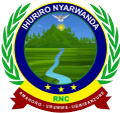II. Rwandan politics and need for Profound Political Reform Rwanda is landlocked and hilly country with a high density of human
settlement. Though linguistically and culturally homogeneous, the population of Rwanda is consisted among others of two large groups, The Hutus and the Tutsis. During the colonial period Rwanda formed part of the German East Africa and later Belgian ruled until Rwanda become independent in 1962.The colonial powers ruled indirectly through Tutsi chiefs. However, with independence approaching, the transitional rule became increasingly challenged by the more numerous Hutus, who demanded social and political position and power. The oppressive Hutu republic was established in 1961, and large numbers of Tutsis fled to its neighboring countries: Democratic republic of Congo (DRC), Burundi, Uganda and Tanzania.
The Rwandan refugees who had been in Uganda since the 1960s turned
The Rwandan refugees who had been in Uganda since the 1960s turned increasingly militants. Trained in the guerrilla fighting in Uganda, the Rwanda Patriotic Front (RPF) prepared for invasion into Rwanda and began attacking the country from the northeast. The group consisted mainly of Tutsi exiles, which had helped Yoweri Museveni’s National Resistance Army come to power in Uganda. Within Rwanda, the political challenge to the dictatorial Juvenal Habyarimana regime grew in strength, setting up opposition parties
and demanding greater power sharing in national politics.
Confronted with mounting pressure, the government decided to open the way for coalition building with various opposition groups as well as to enter preliminary talks with the RPF. Peace talks started between the government and the RPF.
Final peace agreement was signed in Arusha
On August 4 th 1993, a final peace agreement was signed in Arusha, Tanzania. It provided for the establishment of a broad-based transitional government until elections, the repatriation of refugees, and the integration of the forces of the two sides. It called for the creation of United Nations Assistance Mission to Rwanda (UNAMIR) to serve as a neutral monitoring force to ensure the fair application of the Arusha Agreement.
 On April 6 th 1994, the plan carrying the president of Rwanda and Burundi from Arusha was shot down just before landing in Kigali from Arusha. Evidence is emerging that RPF was responsible for this inhuman act. Within an hour of the crash the presidential guard set up the first of many roadblocks, and violence spread through the capital. Tutsis were killed because they were Tutsis and the Hutus considered to be in sympathy with the democratic opposition parties were also murdered. The number of civilians massacred in Rwanda; altogether, 800,000 become victims of genocide
On April 6 th 1994, the plan carrying the president of Rwanda and Burundi from Arusha was shot down just before landing in Kigali from Arusha. Evidence is emerging that RPF was responsible for this inhuman act. Within an hour of the crash the presidential guard set up the first of many roadblocks, and violence spread through the capital. Tutsis were killed because they were Tutsis and the Hutus considered to be in sympathy with the democratic opposition parties were also murdered. The number of civilians massacred in Rwanda; altogether, 800,000 become victims of genocide
